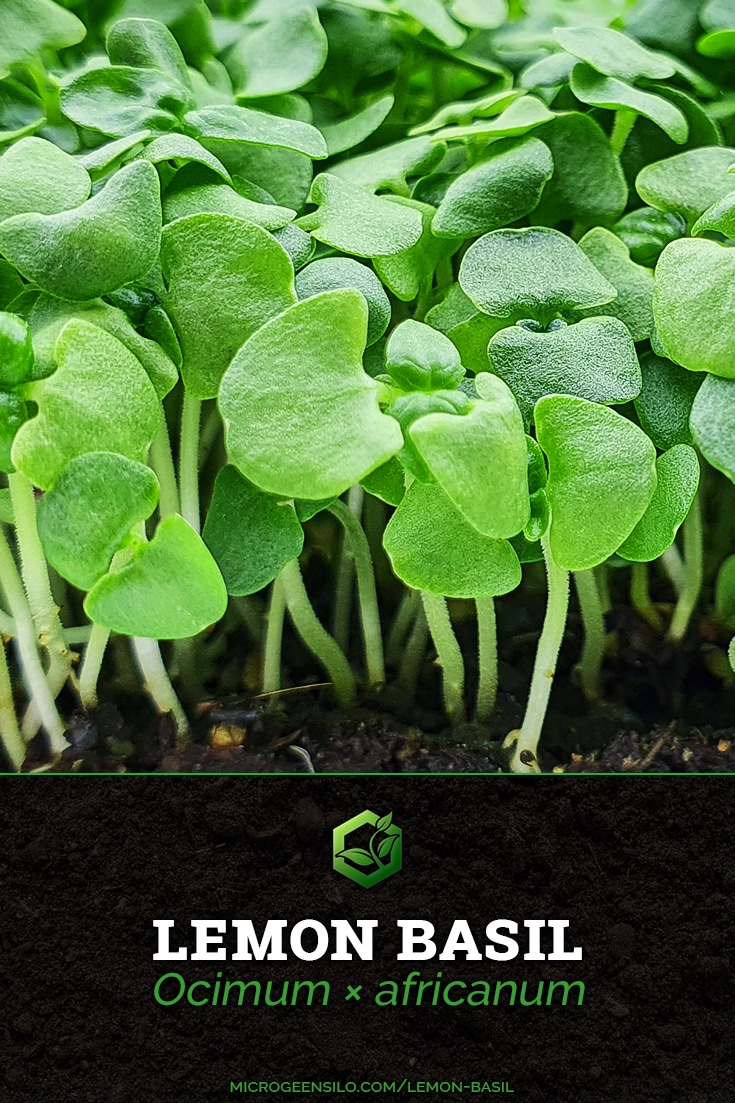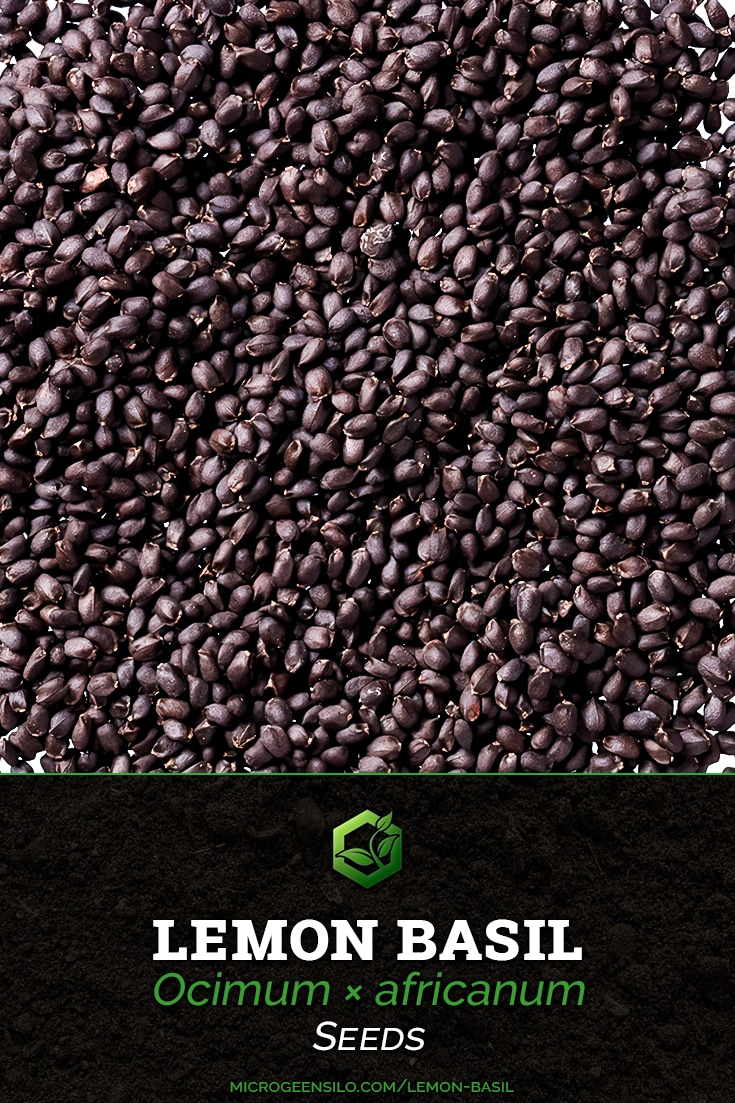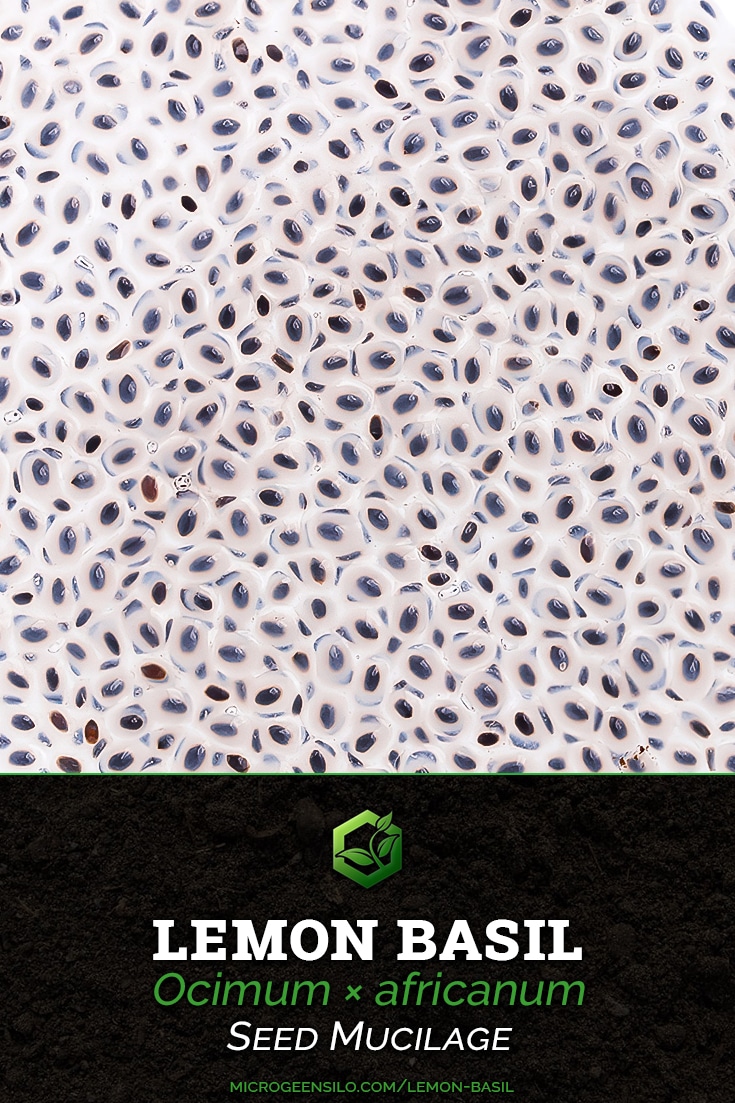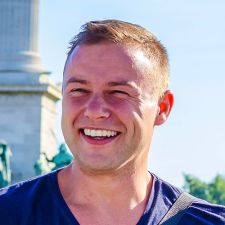Lemon
Basil
Ocimum × africanum Lour.
Lemon basil microgreens, with their sun-ripened lemon essence and vibrant green leaves, add a tangy, aromatic touch to salads, teas, and garnishes, infusing meals with a burst of zesty brightness.
Quick Grow Info:
-
Scientific Name: Ocimum × africanum
-
Flavor: Aromatic, Citrusy lemon notes
-
Seed Rate: 15g-20g per 10″ x 20″ tray
-
Seeds Per in2: 0.075g-0.1g
-
Pre-Soak: No
-
Weight Duration: 3-4 Days
-
Germination Time: 3-4 Days
-
Blackout Time: 2-3 Days
-
Seed To Harvest: 20-25 Days
-
Growing Difficulty: Moderate
Did You Know
Fun Fact
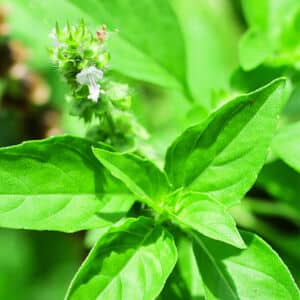
Lemon Basil Ocimum × africanum is a hybrid basil variety resulting from the crossbreeding of two basil species, Ocimum basilicum (sweet basil) and Ocimum americanum (African basil).
Plant Details &
Grow Guide
Growing Lemon Basil Microgreens
If you love Genovese Basil, you definitely ought to try Lemon Basil microgreens! These tiny and incredibly nutritious microgreens not only bring a burst of exquisite basil flavor to your dishes, but they also offer an exquisite lemon aroma.
Let’s walk through the step-by-step process of cultivating these vibrant emerald greens right in the comfort of your home. So grab your green thumb, and let’s begin!
Step 1 Preparing Your Lemon Basil Seeds
First, you need to measure your seeds using a scale. The best seeding rate for a 10″ × 20″ tray is 10-15 grams. If you plan to grow them in a 10″ × 10″ tray then simply divide the total amount by two, in this case, 5-8 grams.
If you’re a rebel like me you can just eyeball it without weighing, just make sure that your seeds are approx ⅛-¼” (3-6mm) apart.
Once you’ve measured out your seeds you do not need to wash and pre-soak them. This is because lemon basil seeds are mucilaginous, and wetting them will make it a nightmare to spread them evenly on your growing medium.
Step 2 Sowing Your Seeds
Fill your tray with your preferred medium, it can be soil, potting mix, coco coir, etc, leaving 1-2cm of empty space from the tray edge to the soil level.
Leaving a small space between the tray edge and grow medium helps when it comes to harvesting, minimizing the chance of digging into the medium with your knife.
Make sure you level your medium with your hands so it’s not clumpy, you don’t want your seeds grouping together when you sow them.
First, mist your medium with a spray bottle so it’s damp but not saturated, I recommend this because when you sow your seeds they won’t bounce around and instead stick to the medium.
Spread your seeds across the medium making sure they’re evenly spread out. Lastly, mist your seeds so they’re all covered with a fine mist of water.
Step 3 Germination & Weight Period
Grab an empty tray with no holes and place it on top of your sowed seeds. I use a 15lb (6.80kg) paving block for 10″ × 20″ trays or a 7lb (3.17 kg) brick on 10″ × 10″ trays.
This helps the seed radicle to bury into the medium when it emerges. Without weight, the radicles have a tougher time digging into the growing medium and anchoring itself.
Keep in mind that the seeds will germinate while they’re covered and weighed down. A lot of people confuse the germination and weight period to be independent of one another and that you add them together, this is incorrect.
The germination time is there to give you an idea by what time the seeds will germinate, but you don’t add the germination time and blackout period together.
While your seeds are germinating and are weighed down you will need to keep your medium moist. You can do this by lightly misting your seeds every 12 hours, once in the morning and once at night.
Step 4 Blackout Time
After 3-4 days of weight period, the seeds should have germinated and the seedlings should now be lifting the empty tray. It’s now time to remove the weight and start the blackout period.
Take your empty tray and flip it upside down to create a blackout dome and place it back over your seeds.
Keeping them in the dark for another 2-3 days will force the freshly sprouted seedlings to stretch and search for light allowing them to get some height.
You can now start bottom watering your lemon basil microgreens. To do this you simply add water to your bottom drain tray. I personally add 1 cup of water twice a day (every 12 hours), once in the morning and once in the evening.
When the 2-3 days of blackout time have passed you can remove the top tray/blackout dome and introduce your microgreens to light. I’ve found that 17 hours under lights and 7 hours with the lights off work well for me.
Grow your Lemon Basil anywhere from 20-25 days, following with daily watering of 2 cups per day, once every 12 hours.
Step 5 Harvest
Harvesting your lemon basil microgreens is straightforward that only requires a sharp tool. Personally, I absolutely love using the Green Mercer Produce Knife—I highly recommend it! But if you prefer scissors, that’s also completely fine; just make sure they’re sharp!
Now, here’s an important tip to keep your harvest pristine; make sure to keep your chosen tool (whether it’s a knife or scissors) away from the soil! It’s imperative in avoiding any accidental contact between the blade and the soil, you don’t want any unwanted dirt from sneaking into your microgreen harvest and contaminating it.
By following this important pointer, you’ll ensure that your harvested microgreens are of top notch quality and purity.
Plant Details & Taxonomy
Lemon basil is a hybrid type of basil created by crossing two species, Ocimum basilicum (sweet basil) and Ocimum americanum (African basil).
Belonging to the Ocimum genus and a member of the Lamiaceae family, it shares botanical ties with other basil relatives.
As an annual herb, it has a lifecycle of one year. A single gram contains between 300 and 500 tiny seeds.
Lemon basil has beautiful emerald green leaves bursting with a lemony citrus scent, giving a range of foods a zesty and refreshing edge.
Its extraordinary flavor is greatly sought after by gardeners and chefs.
It thrives in warmer climates and is most desirable when cultivated as microgreens or baby greens.
| Rank | Scientific Name |
| Kingdom | Plantae – Plants |
| Subkingdom | Tracheobionta – Vascular plants |
| Superdivision | Spermatophyta – Seed plants |
| Division | Magnoliophyta – Flowering plants |
| Class | Magnoliopsida – Dicotyledons |
| Subclass | Asteridae |
| Order | Lamiales |
| Family | Lamiaceae – Mint family |
| Genus | Ocimum L. – Basil |
| Species | Ocimum × africanum Lour. – Lemon Basil |
| Common Names | African basil, Hoary basil, Thai lemon basil, Kumquat basil |
Microgreen Pests & Diseases
The following are the most common pests and diseases that can affect your microgreens.

White Mold – Sclerotinia sclerotiorum
Sclerotinia sclerotiorum is a necrotrophic fungal disease that causes what’s known as white mold, it can infect over 400 plant species worldwide. It’s also called cottony soft rot, stem rot, watery soft rot, crown rot, and seedling blight.
S. sclerotiorum key properties are its ability to create sclerotia which are its black resting structures, and mycelium which are the white fuzzy spiderweb-like growths you see on stems and growing medium.
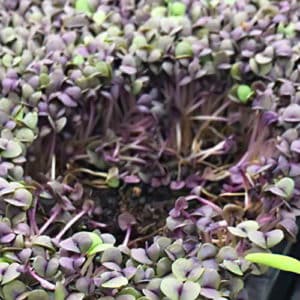
Damping Off
Damping-off is an umbrella term that covers fungi and fungi-like organisms in several genera including Rhizoctonia, Botrytis, Phytophthora, and Fusarium, with the soil fungus Pythium being the often culprit.
Damping-off is a soil-borne fungal disease that affects seeds and seedlings typically by rotting of the stems and roots at and below the soil surface.
When a seed germinates the seedling will emerge fine but within 24 hours to a few days will become mushy and water-soaked, collapse at the base of the stem and die.
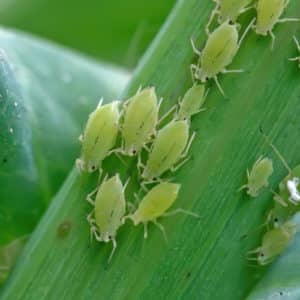
Aphids – Aphidoidea
Aphids suck! Quite literally. They’re soft-bodied insects that use their piercing-sucking mouths to feed on plants and there are over 4,000 aphid species in the world.
Other common names are greenflies, blackflies, and plant lice. They come in varying colors such as light green, black, white, brown, gray, or yellow.
When aphids feed on plants they secrete a sticky fluid which is called honeydew (no, don’t eat it). This goo they leave behind drips onto plants and can attract other pests such as ants. If the honeydew is left on leaves it can promote black sooty mold.
Lemon Basil Nutrition Facts
Lemon basil microgreens are low in calories (23 Kcal per serving) and high in nutrients.
They provide 2.65g of carbohydrates, 3.15g of protein, and 1.6g of dietary fiber, making them a healthy addition to a balanced diet.
They contain no cholesterol and only 0.64g of total fat.
Lemon basil microgreens are rich in vitamins A, C, and K, and essential minerals such as calcium, iron, magnesium, copper, and zinc.
You can add them to your meals easily by incorporating them into salads, sandwiches, or using them as a garnish.
| Principle | Nutrient Value | Unit | RDA |
| Energy | 23 | Kcal | 1% |
| Carbohydrates | 2.65 | g | 2% |
| Protein | 3.15 | g | 6% |
| Total Fat | 0.64 | g | 1% |
| Cholesterol | 0 | mg | 0% |
| Dietary Fiber | 1.6 | g | 4% |
| Vitamins | |||
| Choline | 11.4 | µg | 2% |
| Folate | 68 | µg | 17% |
| Selenium, Se | 0.3 | µg | 1% |
| Vitamin A | 264 | mg | 352% |
| Vitamin B1 (Thiamin) | 0.034 | mg | 3% |
| Vitamin B2 (Riboflavin) | 0.076 | mg | 6% |
| Vitamin B3 (Niacin) | 0.902 | mg | 6% |
| Vitamin B-6 (Pyridoxin) | 0.155 | mg | 12% |
| Vitamin C | 18 | mg | 20% |
| Vitamin E | 0.8 | mg | 5% |
| Vitamin K | 415 | µg | 346% |
| Electrolytes | |||
| Sodium, Na | 4 | mg | 0.27% |
| Potassium, K | 295 | mg | 6.28% |
| Minerals | |||
| Calcium, Ca | 177 | mg | 17.70% |
| Copper, Cu | 0.385 | mg | 42.78% |
| Iron, Fe | 3.17 | mg | 39.63% |
| Magnesium, Mg | 64 | mg | 15.61% |
| Manganese, Mn | 0 | mg | 0.00% |
| Phosphorus, P | 56 | mg | 8.00% |
| Potassium, K | 295 | mg |
6.28% |
| Zinc, Zn | 0.81 | mg | 7.36% |
| Phytonutrients | |||
| β-Carotene, beta | 3140 | µg | 78.50% |
| α-Carotene, alpha | 0 | µg | 0.00% |
| Lutein + zeaxanthin | 5650 | µg | 94.17% |
Recommended Products
Explore my top curated picks for products needed to grow microgreens. Rest assured that all the featured items and products have been meticulously put to the test by me or have received glowing recommendations from my esteemed readers.
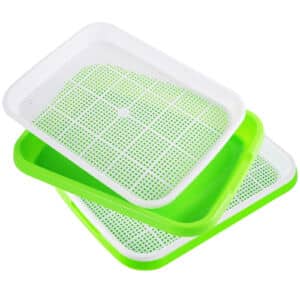
Microgreen Grow Trays
For my personal home use, these microgreen trays are my go to. Measuring around 12.2 x 9.06 x 1.77 inches (31 x 23 x 4.5 cm), these trays are perfectly suited for cultivating microgreens in a home microgreen grow room. What’s more, they’re durable, and cleaning them is a walk in the park, making them an all-around convenient choice.
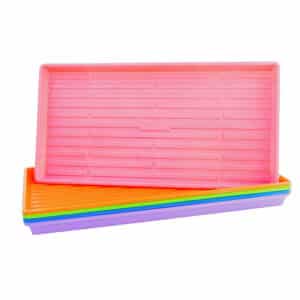
1020 Microgreen Trays – Shallow Extra Strength Colors
Industry leading BootStrap Farmers 1020 microgreen trays! Designed with long lasting durability in mind, these colorful trays are built to withstand years of use and abuse. With a height of 1¼ inches (3.2 cm), these shallow trays make harvests easy, saving you time and increasing your yield. The trays come equipped with 36 drainage holes that effectively remove excess water, promoting a healthy growing environment and preventing mold growth. If you’re serious about growing microgreens and want the best trays available on the market, these trays are it!
